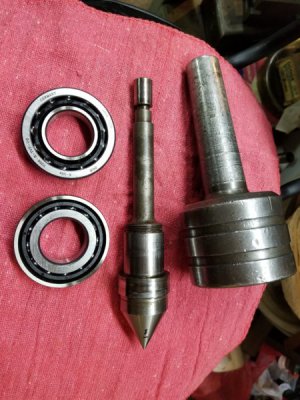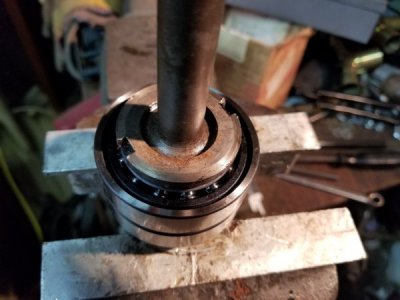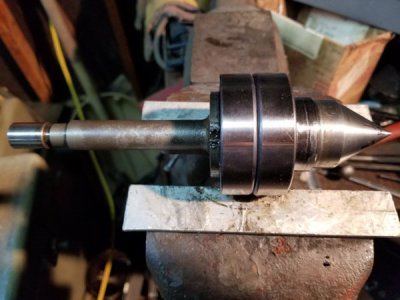-
Welcome back Guest! Did you know you can mentor other members here at H-M? If not, please check out our Relaunch of Hobby Machinist Mentoring Program!
You are using an out of date browser. It may not display this or other websites correctly.
You should upgrade or use an alternative browser.
You should upgrade or use an alternative browser.
Replacing bearings in my Live Center
- Thread starter TORQUIN
- Start date
- Joined
- Nov 25, 2015
- Messages
- 8,338
And to add to what kd4gij said, there are C2, CN, C3... those are for clearance. CN being normal, 2 being closer tolerances, tighter, and c3 being looser.
That, I do not know. I bought FAG 7206B-TVP-UO, but never saw any specifications regarding precision. I was having a time even crossing them from the original numbers that came out of the center, as the older bearings were of a different numbering system. I have not yet run across the book with all of the necessary info to make an informed bearing choice.
Does anyone know what the precision spec is for what I have purchased?
Thanks,
Chris
Does anyone know what the precision spec is for what I have purchased?
Thanks,
Chris
- Joined
- Mar 3, 2017
- Messages
- 747
That, I do not know. I bought FAG 7206B-TVP-UO, but never saw any specifications regarding precision....
Does anyone know what the precision spec is for what I have purchased?
That's the thrust bearing, so its centering depends on some thrust load being applied.
Did the runout test (and the grinding, for that matter) both get an axial-direction force applied?
That's important!
When testing the center I put it in the lathe and ran it up to a countersunk hole in a part so that I could turn the center with the chuck while indicating it. When it a grinder the last time the bearings were removed and the spindle was riding in a fitted collar I made for the tool grinder. It is a very tight fit on the bearing surface of the spindle, but not a press fit.
There are two of those bearings inside, with the outer races butted to each other and inner races tightened between the spindle head shoulder and a nut, to provide preload on the bearings.



Thanks,
Chris
There are two of those bearings inside, with the outer races butted to each other and inner races tightened between the spindle head shoulder and a nut, to provide preload on the bearings.



Thanks,
Chris
- Joined
- Mar 3, 2017
- Messages
- 747
When testing the center I put it in the lathe and ran it up to a countersunk hole in a part ...t.
There are two of those bearings inside, with the outer races butted to each other and inner races tightened between the spindle head shoulder and a nut, to provide preload on the bearings.
One 'factory preload' recommendation is to butt the inner races between the two bearings, and then there's
no tightening nut, just pressed outer races against shoulders. Using a nut for preload ought to be good,
but does FAG recommend that? Website talks about schragkugellager and loses me...
FAG angular contact 7200 series.
Search for '30206' at that website search page does pull up ND, and shows 7206-B-XL-JP
How does the nut get adjusted? If the spindle is slip-fit in the bearings, is it glued so as not to
shift after assembly?
- Joined
- Jan 29, 2017
- Messages
- 311
What's the fit between shaft and inner races?
Are the inner race seats on the shaft worn at all? Or is there too much clearance? Should be a smooth to firm sliding fit.
Is there a bush deep down for the pilot? If so it will allow eccentricity because of wear.
Are your bearings matched? You'll have a better chance of minimal runout if thats the case.
I think you should mount the bearings inner races out (cones butted) and use the nut to set the tiniest amount of preload you can feel.
Use some wickin loctite (290 I think) after setting preload.
Are the inner race seats on the shaft worn at all? Or is there too much clearance? Should be a smooth to firm sliding fit.
Is there a bush deep down for the pilot? If so it will allow eccentricity because of wear.
Are your bearings matched? You'll have a better chance of minimal runout if thats the case.
I think you should mount the bearings inner races out (cones butted) and use the nut to set the tiniest amount of preload you can feel.
Use some wickin loctite (290 I think) after setting preload.
Last edited:
How did you mount them? Face to face, back to back or tandem?That, I do not know. I bought FAG 7206B-TVP-UO, but never saw any specifications regarding precision.
Thanks,
Chris
Sorry I have gotten back to this. Apparently there were more replies but the site did not alert me.
Anyway, I butted the outer races to each other, then tightened the nut against the inner races, to press the ball bearings into the curve of the outer race. This provides the pre-load so there is zero thrust on the spindle.
Since my last post I finally got around to making another collet for the tool grinder and ground the last .011" with it installed in the work head. I then reground the spindle, with all bearings removed, and now have less than .0005" run out. I am quite happy with the result.
Thanks,
Chris
Anyway, I butted the outer races to each other, then tightened the nut against the inner races, to press the ball bearings into the curve of the outer race. This provides the pre-load so there is zero thrust on the spindle.
Since my last post I finally got around to making another collet for the tool grinder and ground the last .011" with it installed in the work head. I then reground the spindle, with all bearings removed, and now have less than .0005" run out. I am quite happy with the result.
Thanks,
Chris

